ESP FIAT IDEA 2007 1.G Owner's Manual
[x] Cancel search | Manufacturer: FIAT, Model Year: 2007, Model line: IDEA, Model: FIAT IDEA 2007 1.GPages: 314, PDF Size: 4.78 MB
Page 144 of 314

ACCESSORIES PURCHASED BY
THE OWNER
If, after buying the car, you decide to install electrical
accessories that require a permanent electric supply
(alarm, satellite antitheft system, etc.) or accessories that
in any case burden the electric supply, contact Fiat
Dealership, whose qualified personnel, besides suggesting
the most suitable devices belonging to Lineaccessori Fiat,
will also evaluate the overall electric absorption,
checking whether the vehicle electric system is able to
withstand the load required, or whether it needs to be
integrated with a more powerful battery.
INSTALLATION OF ELECTRIC/
ELECTRONIC DEVICES
Electric/electronic devices installed after buying the car
or in aftermarket shall bear the and marking:
Fiat Auto S.p.A. authorizes the installation of
transceivers provided that installation is carried out at
a specialized shop, workmanlike performed and in
compliance with manufacturer's specifications.
IMPORTANT Installation of devices resulting in
modifications of car characteristics may cause driving
license seizing by traffic agents and also the lapse of
143
SAFETY
DEVICES
CORRECT USE
OF THE CAR
WARNING
LIGHTS AND
MESSAGES
IN AN
EMERGENCY
CAR
MAINTENANCE
TECHNICAL
SPECIFICATIONS
INDEX
DASHBOARD
AND CONTROLS
WARNINGBe careful when mounting additional spoilers, alloy rims and non original wheel
caps: they may reduce the brake ventilation and efficiency during sharp and
repeated braking or sloping downhill. Also make sure that nothing (over-carpeting,
etc.) interferes with the pedal stroke.
the warranty as concerns defects due to the
abovementioned modification or traceable back to it
directly or indirectly.
Fiat Auto S.p.A. declines all responsibility for damages
caused by the installation of non-genuine accessories
or not recommended by Fiat Auto S.p.A. and installed
not in compliance with the specified requirements.
RADIO TRANSMITTERS AND CELLULAR
TELEPHONES
Radio transceiver equipment (e.g.: e-tacs mobile
phones, HAM radio systems and the like) shall not be
used inside the vehicle unless a separate aerial is
mounted on the roof.
IMPORTANT The use of similar devices inside the
passenger compartment (without separated aerial)
produces radio-frequency electromagnetic fields
which, amplified by the resonance effects inside the
passenger compartment, may cause electrical systems
equipping the vehicle to malfunction. This could
compromise safety in addition to constituting a
potential hazard for the passengers.
In addition, transmission and reception of these
devices may be affected by the shielding effect of the
vehicle body.
As concerns EC-approved mobile phones (GSM,
GPRS, UMTS), strictly comply with the instructions for
use provided by the mobile phone’s manufacturer.
Page 146 of 314
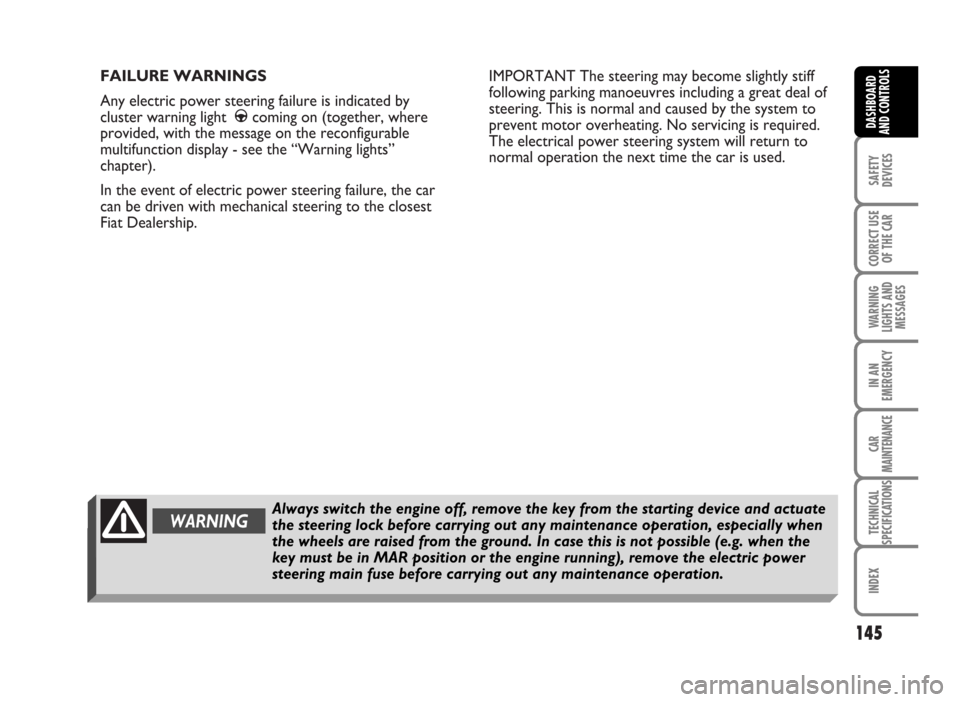
FAILURE WARNINGS
Any electric power steering failure is indicated by
cluster warning light gcoming on (together, where
provided, with the message on the reconfigurable
multifunction display - see the “Warning lights”
chapter).
In the event of electric power steering failure, the car
can be driven with mechanical steering to the closest
Fiat Dealership.IMPORTANT The steering may become slightly stiff
following parking manoeuvres including a great deal of
steering. This is normal and caused by the system to
prevent motor overheating. No servicing is required.
The electrical power steering system will return to
normal operation the next time the car is used.
145
SAFETY
DEVICES
CORRECT USE
OF THE CAR
WARNING
LIGHTS AND
MESSAGES
IN AN
EMERGENCY
CAR
MAINTENANCE
TECHNICAL
SPECIFICATIONS
INDEX
DASHBOARD
AND CONTROLS
WARNINGAlways switch the engine off, remove the key from the starting device and actuate
the steering lock before carrying out any maintenance operation, especially when
the wheels are raised from the ground. In case this is not possible (e.g. when the
key must be in MAR position or the engine running), remove the electric power
steering main fuse before carrying out any maintenance operation.
Page 148 of 314
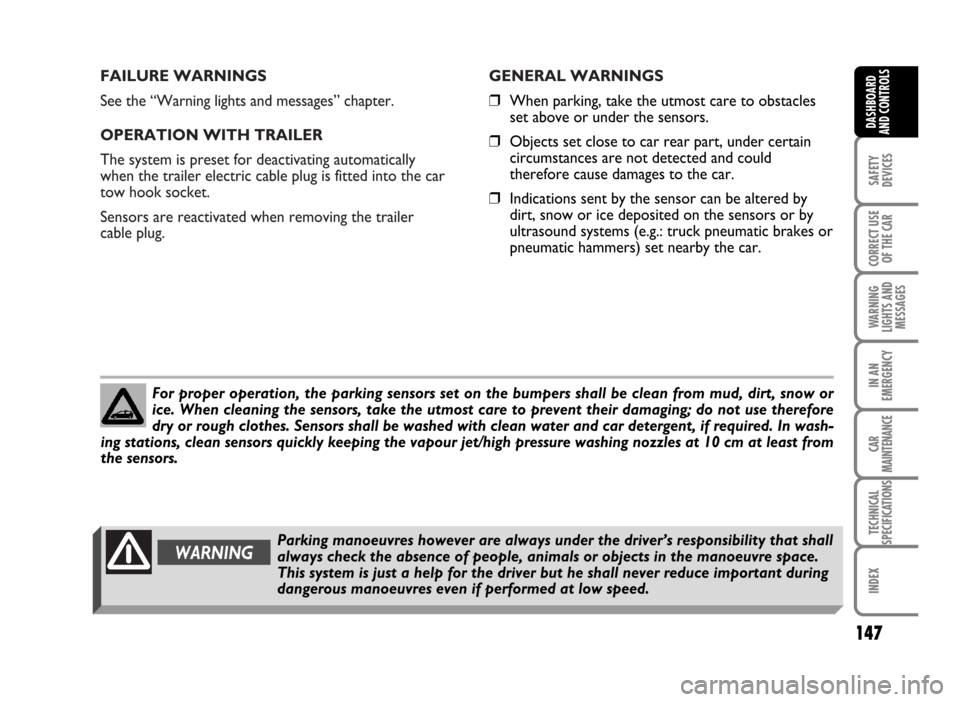
FAILURE WARNINGS
See the “Warning lights and messages” chapter.
OPERATION WITH TRAILER
The system is preset for deactivating automatically
when the trailer electric cable plug is fitted into the car
tow hook socket.
Sensors are reactivated when removing the trailer
cable plug.GENERAL WARNINGS
❒When parking, take the utmost care to obstacles
set above or under the sensors.
❒Objects set close to car rear part, under certain
circumstances are not detected and could
therefore cause damages to the car.
❒Indications sent by the sensor can be altered by
dirt, snow or ice deposited on the sensors or by
ultrasound systems (e.g.: truck pneumatic brakes or
pneumatic hammers) set nearby the car.
147
SAFETY
DEVICES
CORRECT USE
OF THE CAR
WARNING
LIGHTS AND
MESSAGES
IN AN
EMERGENCY
CAR
MAINTENANCE
TECHNICAL
SPECIFICATIONS
INDEX
DASHBOARD
AND CONTROLS
For proper operation, the parking sensors set on the bumpers shall be clean from mud, dirt, snow or
ice. When cleaning the sensors, take the utmost care to prevent their damaging; do not use therefore
dry or rough clothes. Sensors shall be washed with clean water and car detergent, if required. In wash-
ing stations, clean sensors quickly keeping the vapour jet/high pressure washing nozzles at 10 cm at least from
the sensors.
WARNINGParking manoeuvres however are always under the driver’s responsibility that shall
always check the absence of people, animals or objects in the manoeuvre space.
This system is just a help for the driver but he shall never reduce important during
dangerous manoeuvres even if performed at low speed.
Page 179 of 314
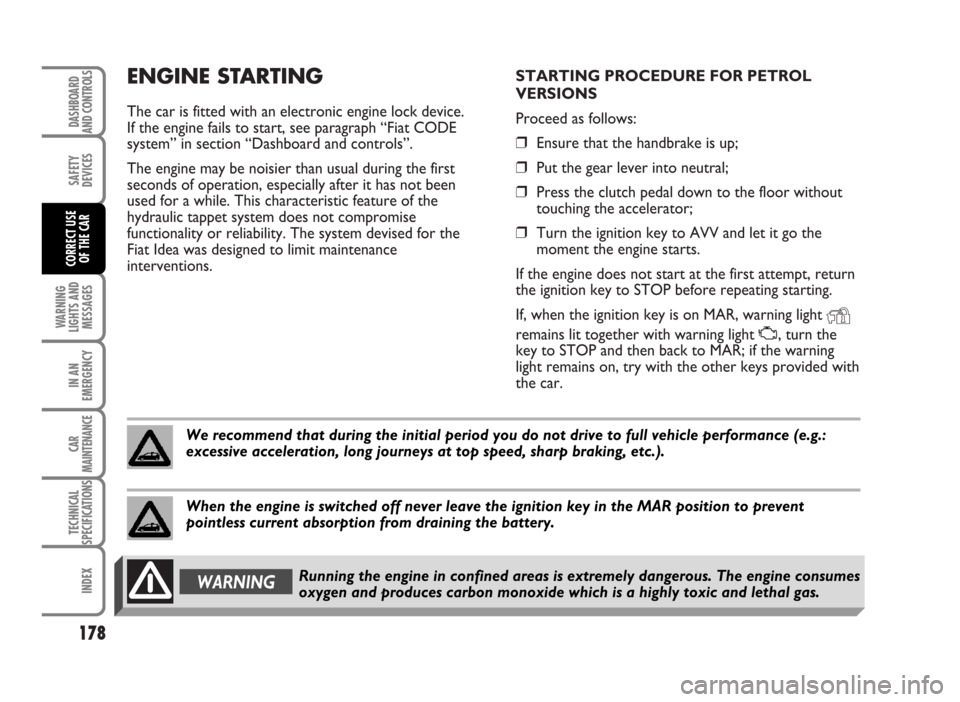
ENGINE STARTING
The car is fitted with an electronic engine lock device.
If the engine fails to start, see paragraph “Fiat CODE
system” in section “Dashboard and controls”.
The engine may be noisier than usual during the first
seconds of operation, especially after it has not been
used for a while. This characteristic feature of the
hydraulic tappet system does not compromise
functionality or reliability. The system devised for the
Fiat Idea was designed to limit maintenance
interventions.STARTING PROCEDURE FOR PETROL
VERSIONS
Proceed as follows:
❒Ensure that the handbrake is up;
❒Put the gear lever into neutral;
❒Press the clutch pedal down to the floor without
touching the accelerator;
❒Turn the ignition key to AVV and let it go the
moment the engine starts.
If the engine does not start at the first attempt, return
the ignition key to STOP before repeating starting.
If, when the ignition key is on MAR, warning light
Y
remains lit together with warning light U, turn the
key to STOP and then back to MAR; if the warning
light remains on, try with the other keys provided with
the car.
178
SAFETY
DEVICES
WARNING
LIGHTS AND
MESSAGES
IN AN
EMERGENCY
CAR
MAINTENANCE
TECHNICAL
SPECIFICATIONS
INDEX
DASHBOARD
AND CONTROLS
CORRECT USE
OF THE CAR
We recommend that during the initial period you do not drive to full vehicle performance (e.g.:
excessive acceleration, long journeys at top speed, sharp braking, etc.).
When the engine is switched off never leave the ignition key in the MAR position to prevent
pointless current absorption from draining the battery.
WARNINGRunning the engine in confined areas is extremely dangerous. The engine consumes
oxygen and produces carbon monoxide which is a highly toxic and lethal gas.
Page 181 of 314
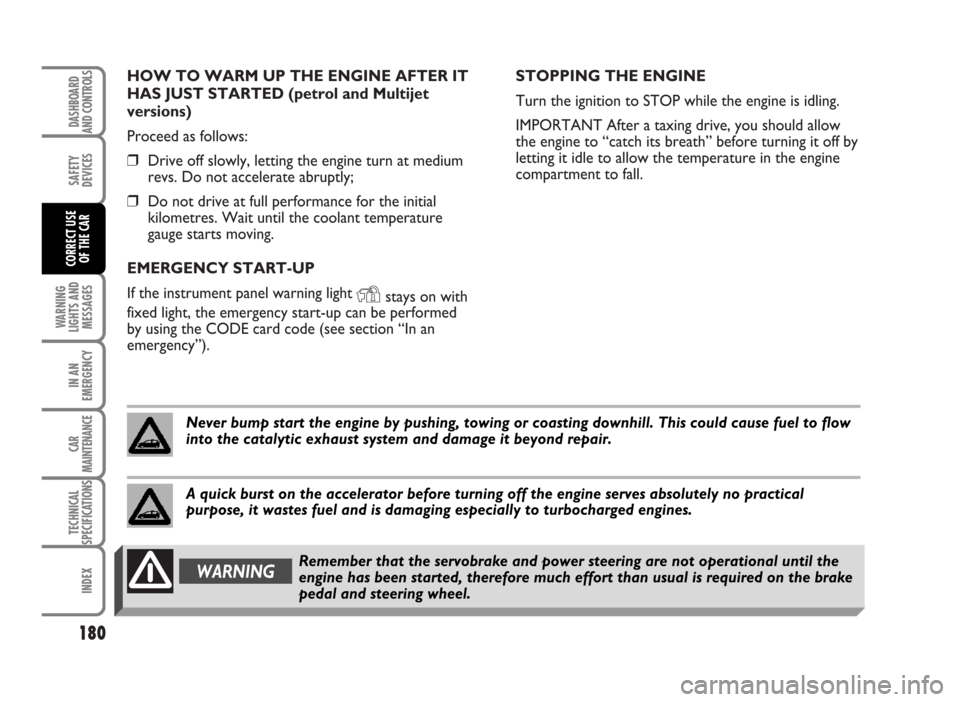
HOW TO WARM UP THE ENGINE AFTER IT
HAS JUST STARTED (petrol and Multijet
versions)
Proceed as follows:
❒Drive off slowly, letting the engine turn at medium
revs. Do not accelerate abruptly;
❒Do not drive at full performance for the initial
kilometres. Wait until the coolant temperature
gauge starts moving.
EMERGENCY START-UP
If the instrument panel warning light
Ystays on with
fixed light, the emergency start-up can be performed
by using the CODE card code (see section “In an
emergency”).STOPPING THE ENGINE
Turn the ignition to STOP while the engine is idling.
IMPORTANT After a taxing drive, you should allow
the engine to “catch its breath” before turning it off by
letting it idle to allow the temperature in the engine
compartment to fall.
180
SAFETY
DEVICES
WARNING
LIGHTS AND
MESSAGES
IN AN
EMERGENCY
CAR
MAINTENANCE
TECHNICAL
SPECIFICATIONS
INDEX
DASHBOARD
AND CONTROLS
CORRECT USE
OF THE CAR
Never bump start the engine by pushing, towing or coasting downhill. This could cause fuel to flow
into the catalytic exhaust system and damage it beyond repair.
A quick burst on the accelerator before turning off the engine serves absolutely no practical
purpose, it wastes fuel and is damaging especially to turbocharged engines.
Remember that the servobrake and power steering are not operational until the
engine has been started, therefore much effort than usual is required on the brake
pedal and steering wheel.WARNING
Page 184 of 314
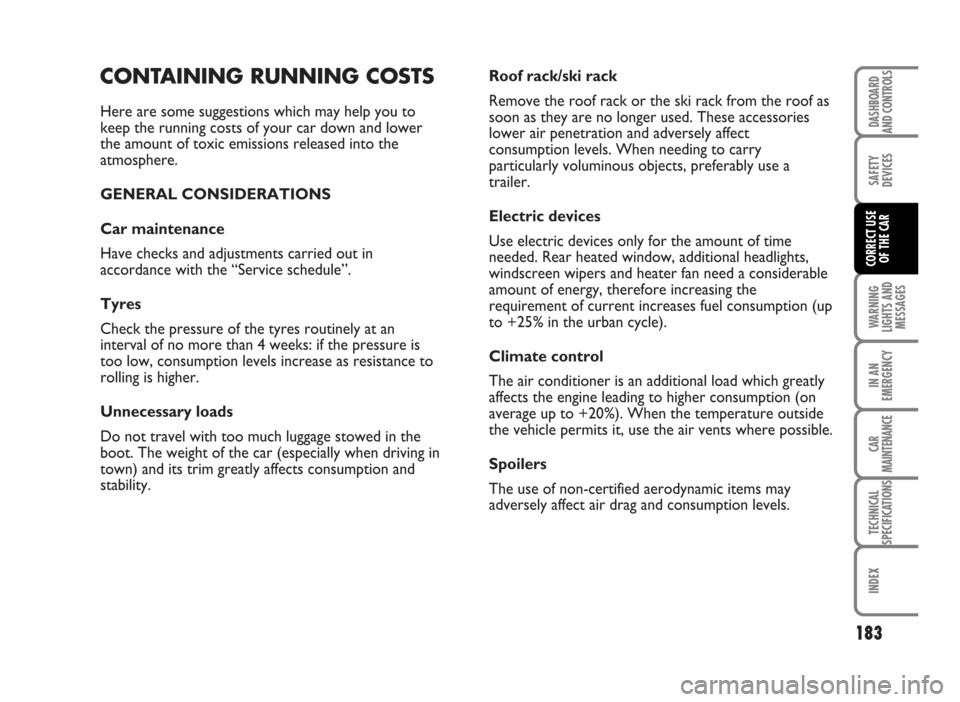
CONTAINING RUNNING COSTS
Here are some suggestions which may help you to
keep the running costs of your car down and lower
the amount of toxic emissions released into the
atmosphere.
GENERAL CONSIDERATIONS
Car maintenance
Have checks and adjustments carried out in
accordance with the “Service schedule”.
Tyres
Check the pressure of the tyres routinely at an
interval of no more than 4 weeks: if the pressure is
too low, consumption levels increase as resistance to
rolling is higher.
Unnecessary loads
Do not travel with too much luggage stowed in the
boot. The weight of the car (especially when driving in
town) and its trim greatly affects consumption and
stability.Roof rack/ski rack
Remove the roof rack or the ski rack from the roof as
soon as they are no longer used. These accessories
lower air penetration and adversely affect
consumption levels. When needing to carry
particularly voluminous objects, preferably use a
trailer.
Electric devices
Use electric devices only for the amount of time
needed. Rear heated window, additional headlights,
windscreen wipers and heater fan need a considerable
amount of energy, therefore increasing the
requirement of current increases fuel consumption (up
to +25% in the urban cycle).
Climate control
The air conditioner is an additional load which greatly
affects the engine leading to higher consumption (on
average up to +20%). When the temperature outside
the vehicle permits it, use the air vents where possible.
Spoilers
The use of non-certified aerodynamic items may
adversely affect air drag and consumption levels.
183
SAFETY
DEVICES
WARNING
LIGHTS AND
MESSAGES
IN AN
EMERGENCY
CAR
MAINTENANCE
TECHNICAL
SPECIFICATIONS
INDEX
DASHBOARD
AND CONTROLS
CORRECT USE
OF THE CAR
Page 193 of 314

192
SAFETY
DEVICES
CORRECT USE
OF THE CAR
IN AN
EMERGENCY
CAR
MAINTENANCE
TECHNICAL
SPECIFICATIONS
INDEX
DASHBOARD
AND CONTROLS
WARNING
LIGHTS AND
MESSAGES
GENERAL WARNINGS
Failure indicationsshown on the reconfigurable
multifunction display together with buzzer sounding
(adjustable) and warning light (if any) coming on on the
cluster, are accompanied by specific warning
messages(e.g.: “Switch off engine”, etc...). These
indications are concise and cautionaryand are
aimed to suggest the prompt actionthe driver must
adopt when a car malfunctioning appears. These
indications, however, shall not be considered as
exhaustive and/or as an alternative to the
specifications contained in this “Owner Handbook”,
which shall always be read through carefully and
thoroughly. In case of failure indication always refer
to the specifications contained in this section.
IMPORTANT Failure indications displayed on the
reconfigurable multifunction display are divided into
two categories: very serious failures and
serious/minor failures.
The message and the warning indication corresponding
to very serious failures are displayed alternately for
few seconds. This “cycle” is repeated indefinitely and it
stops any previous indication on the display. It is
displayed every time the ignition key is turned to MAR,
until the cause of malfunctioning is removed. Should failure disappear, message and warning light will
however stay on for about 2 seconds. Eliminating the
failure, the warning light and the displayed message will
go off. It is possible to stop this “cycle” by pressing
button Q; in this case the screen active before the
failure will be resumed and the warning light will stay
on until eliminating the failure cause.
The message and the warning indication corresponding
to serious/minorfailures are displayed alternately for
few seconds. This “cycle” is repeated for about 20
seconds and then goes off, but it comes on again every
time the ignition key is turned to MAR.
Should failure disappear during the 20 seconds
displaying, message and warning light will stay on for
about 2 seconds. Eliminating the failure, the warning
light and the displayed message will go off.
At the end of the display cycle (which lasts approx. 20
seconds), or if button Qis pressed, the screen active
before the failure will be resumed and the warning
light will stay on until eliminating the failure cause.
Q= Press button “MODE” for less than two seconds
R= Press button “MODE” for over two seconds
Page 223 of 314

222
SAFETY
DEVICES
CORRECT USE
OF THE CAR
WARNING
LIGHTS AND
MESSAGES
CAR
MAINTENANCE
TECHNICAL
SPECIFICATIONS
INDEX
DASHBOARD
AND CONTROLS
IN AN
EMERGENCY
ENGINE STARTING
EMERGENCY START-UP
If the Fiat CODE cannot deactivate the engine
immobilising system, the
Yand Uwarning lights
stay on and the engine will not start.
To start the engine the emergency start-up can be
performed.
Read the whole procedure carefully before trying to
carry it out. If you make a mistake, you must turn the
ignition key back to STOP and repeat the whole
operation from beginning.
Proceed as follows:
❒Read the 5-figure electronic code given on the
CODE card;
❒Turn the ignition key to MAR;
❒Press and hold down the accelerator pedal. The
instrument panel warning light
Uwill come on for
about 8 seconds and then go out;
❒Release the accelerator pedal and get ready to
count the flashes of the
Uwarning light;
❒Count the number of flashes that corresponds to
the first figure of the code on the CODE card, then
press the accelerator pedal and keep it there until
the
Uwarning light comes on for four seconds
and then goes out; release the accelerator pedal;
❒The Uwarning light will start flashing again: after it
has flashed the number of times that corresponds
to the second figure on the CODE card, press the
accelerator pedal to the floor and keep it there;
❒Do the same for the remaining figures on the
CODE card;
❒Once the final figure has been entered, keep the
accelerator pedal pressed. The
Uwarning light
will light up for four seconds and then go out;
release the accelerator pedal;
❒Rapid flashing of the warning light U(for about 4
seconds) confirms the operation has been carried
out successfully;
❒Start the engine by turning the ignition key from
MAR to AVV.
If however the warning light
Ustays on, turn the
ignition key to STOP and repeat the procedure from
step one
IMPORTANT After an emergency start-up, you should
contact a Fiat Dealership otherwise you will have to
repeat the procedure described each time you want to
start the engine.
Page 225 of 314
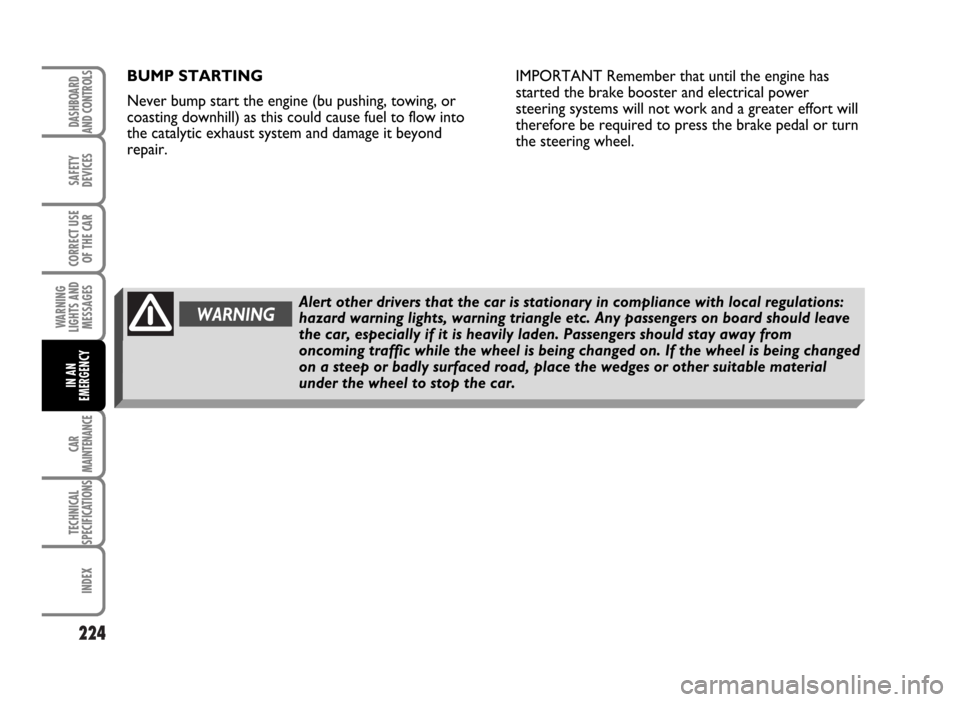
224
SAFETY
DEVICES
CORRECT USE
OF THE CAR
WARNING
LIGHTS AND
MESSAGES
CAR
MAINTENANCE
TECHNICAL
SPECIFICATIONS
INDEX
DASHBOARD
AND CONTROLS
IN AN
EMERGENCY
BUMP STARTING
Never bump start the engine (bu pushing, towing, or
coasting downhill) as this could cause fuel to flow into
the catalytic exhaust system and damage it beyond
repair.IMPORTANT Remember that until the engine has
started the brake booster and electrical power
steering systems will not work and a greater effort will
therefore be required to press the brake pedal or turn
the steering wheel.
WARNINGAlert other drivers that the car is stationary in compliance with local regulations:
hazard warning lights, warning triangle etc. Any passengers on board should leave
the car, especially if it is heavily laden. Passengers should stay away from
oncoming traffic while the wheel is being changed on. If the wheel is being changed
on a steep or badly surfaced road, place the wedges or other suitable material
under the wheel to stop the car.
Page 229 of 314
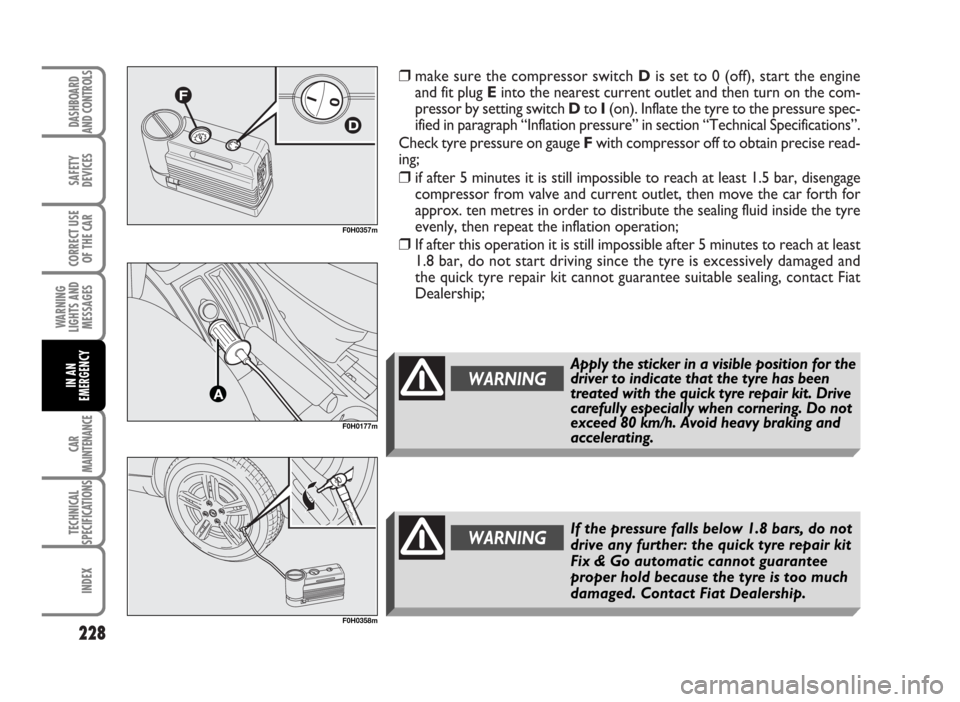
❒make sure the compressor switch Dis set to 0 (off), start the engine
and fit plug Einto the nearest current outlet and then turn on the com-
pressor by setting switch D to I(on). Inflate the tyre to the pressure spec-
ified in paragraph “Inflation pressure” in section “Technical Specifications”.
Check tyre pressure on gauge Fwith compressor off to obtain precise read-
ing;
❒if after 5 minutes it is still impossible to reach at least 1.5 bar, disengage
compressor from valve and current outlet, then move the car forth for
approx. ten metres in order to distribute the sealing fluid inside the tyre
evenly, then repeat the inflation operation;
❒If after this operation it is still impossible after 5 minutes to reach at least
1.8 bar, do not start driving since the tyre is excessively damaged and
the quick tyre repair kit cannot guarantee suitable sealing, contact Fiat
Dealership;
228
SAFETY
DEVICES
CORRECT USE
OF THE CAR
WARNING
LIGHTS AND
MESSAGES
CAR
MAINTENANCE
TECHNICAL
SPECIFICATIONS
INDEX
DASHBOARD
AND CONTROLS
IN AN
EMERGENCY
F0H0357m
F0H0177m
F0H0358m
WARNINGIf the pressure falls below 1.8 bars, do not
drive any further: the quick tyre repair kit
Fix & Go automatic cannot guarantee
proper hold because the tyre is too much
damaged. Contact Fiat Dealership.
WARNING
Apply the sticker in a visible position for the
driver to indicate that the tyre has been
treated with the quick tyre repair kit. Drive
carefully especially when cornering. Do not
exceed 80 km/h. Avoid heavy braking and
accelerating.